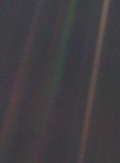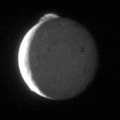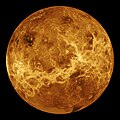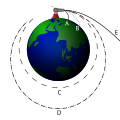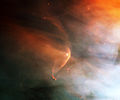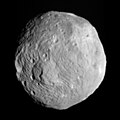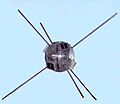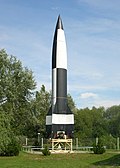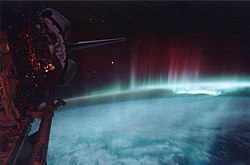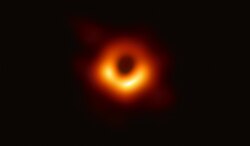Portal maintenance status: (April 2019)
|
Introduction
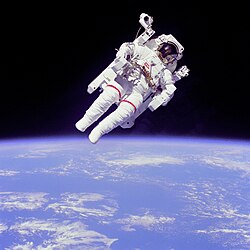
Outer space, or simply space, is the expanse that exists beyond Earth's atmosphere and between celestial bodies. It contains ultra-low levels of particle densities, constituting a near-perfect vacuum of predominantly hydrogen and helium plasma, permeated by electromagnetic radiation, cosmic rays, neutrinos, magnetic fields and dust. The baseline temperature of outer space, as set by the background radiation from the Big Bang, is 2.7 kelvins (−270 °C; −455 °F).
The plasma between galaxies is thought to account for about half of the baryonic (ordinary) matter in the universe, having a number density of less than one hydrogen atom per cubic metre and a kinetic temperature of millions of kelvins. Local concentrations of matter have condensed into stars and galaxies. Intergalactic space takes up most of the volume of the universe, but even galaxies and star systems consist almost entirely of empty space. Most of the remaining mass-energy in the observable universe is made up of an unknown form, dubbed dark matter and dark energy.
Outer space does not begin at a definite altitude above Earth's surface. The Kármán line, an altitude of 100 km (62 mi) above sea level, is conventionally used as the start of outer space in space treaties and for aerospace records keeping. Certain portions of the upper stratosphere and the mesosphere are sometimes referred to as "near space". The framework for international space law was established by the Outer Space Treaty, which entered into force on 10 October 1967. This treaty precludes any claims of national sovereignty and permits all states to freely explore outer space. Despite the drafting of UN resolutions for the peaceful uses of outer space, anti-satellite weapons have been tested in Earth orbit.
The concept that the space between the Earth and the Moon must be a vacuum was first proposed in the 17th century after scientists discovered that air pressure decreased with altitude. The immense scale of outer space was grasped in the 20th century when the distance to the Andromeda Galaxy was first measured. Humans began the physical exploration of space later in the same century with the advent of high-altitude balloon flights. This was followed by crewed rocket flights and, then, crewed Earth orbit, first achieved by Yuri Gagarin of the Soviet Union in 1961. The economic cost of putting objects, including humans, into space is very high, limiting human spaceflight to low Earth orbit and the Moon. On the other hand, uncrewed spacecraft have reached all of the known planets in the Solar System. Outer space represents a challenging environment for human exploration because of the hazards of vacuum and radiation. Microgravity has a negative effect on human physiology that causes both muscle atrophy and bone loss. (Full article...)
Selected article
Apollo 8 was the second manned mission of the Apollo space program. Commander Frank Borman, Command Module Pilot James Lovell and Lunar Module Pilot William Anders became the first humans to travel beyond Earth orbit and into an orbit around the Moon. It was also the first manned launch of the Saturn V rocket. NASA prepared for the mission in only four months. The hardware involved had only been used a few times—the Saturn V had only launched twice before, and the Apollo spacecraft had only just finished its first manned mission, Apollo 7. However the success of the mission paved the way for the successful completion of John F. Kennedy's goal of landing on the Moon before the end of the decade. After launching on December 21, 1968, the crew took three days to travel to the Moon, which they orbited for twenty hours. While in lunar orbit they made a Christmas Eve television broadcast that is thought to be one of the most watched of all time.
Selected picture
-
Image 1

Astronaut Steve Robinson on a spacewalk, August 2005 Credit: NASAExtra-vehicular activity (EVA) is work done by an astronaut away from the Earth and outside of his or her spacecraft. EVAs may be made outside a craft orbiting Earth (a spacewalk) or on the surface of the Moon (a moonwalk). Shown here is Steve Robinson on the first EVA to perform an in-flight repair of the Space Shuttle (August 3 2005). -
Image 2"The Blue Marble" is a famous photograph of Earth. NASA officially credits the image to the entire Apollo 17 crew — Eugene Cernan, Ronald Evans and Jack Schmitt — all of whom took photographic images during the mission. Apollo 17 passed over Africa during daylight hours and Antarctica is also illuminated. The photograph was taken approximately five hours after the spacecraft's launch, while en route to the Moon. Apollo 17, notably, was the last manned lunar mission; no humans since have been at a range where taking a "whole-Earth" photograph such as "The Blue Marble" would be possible.
-
Image 3Six beryllium mirror segments of the James Webb Space Telescope (JWST) undergoing a series of cryogenic tests at NASA's Marshall Space Flight Center in Huntsville, Alabama. The JWST is a planned space telescope that is a joint collaboration of 20 countries. It will orbit the Sun approximately 1,500,000 km (930,000 mi) beyond the Earth, around the L2 Lagrange point. It is expected to launch in December 2021.
-
Image 4Photo credit: Spirit roverA 360° panorama taken during the descent from the summit of Husband Hill, one of the Columbia Hills in Gusev crater, Mars. This stitched image is composed of 405 individual images taken with five different filters on the panoramic camera over the course of five Martian days.
-
Image 5

Color-composite image of the Pleiades from the Digitized Sky Survey Credit: NASA, ESA, AURA/Caltech, Palomar ObservatoryThe Pleiades (also known as M45 or the Seven Sisters) is an open cluster in the constellation of Taurus. It is among the nearest to the Earth of all open clusters, probably the best known and certainly the most striking to the naked eye. -
Image 6Neptune is the eighth and farthest known planet from the Sun in the Solar System. In the Solar System, it is the fourth-largest planet by diameter, the third-most-massive planet and the densest giant planet. Neptune is 17 times the mass of Earth, slightly more massive than its near-twin Uranus. Neptune is denser and physically smaller than Uranus because its greater mass causes more gravitational compression of its atmosphere. Neptune orbits the Sun once every 164.8 years at an average distance of 30.1 au (4.5 billion km; 2.8 billion mi). It is named after the Roman god of the sea and has the astronomical symbol ♆, a stylised version of the god Neptune's trident.
This picture of Neptune was taken by NASA's Voyager 2 spacecraft in 1989, at a range of 4.4 million miles (7.1 million kilometres) from the planet, approximately four days before closest approach. The photograph shows the Great Dark Spot, a storm about the size of Earth, in the centre, while the fast-moving bright feature nicknamed the "Scooter" and the Small Dark Spot can be seen on the western limb. These clouds were seen to persist for as long as the spacecraft's cameras could resolve them. -
Image 7Photograph: Ken CrawfordNGC 4565 (also known as the Needle Galaxy) is an edge-on spiral galaxy about 30 to 50 million light-years away in the constellation Coma Berenices. NGC 4565 is a giant spiral galaxy more luminous than the Andromeda Galaxy, and has a population of roughly 240 globular clusters, more than the Milky Way.
-
Image 8Pale Blue Dot is the name given to this 1990 photo of Earth taken from Voyager 1 when its vantage point reached the edge of the Solar System, a distance of roughly 3.7 billion miles (6 billion kilometres). Earth can be seen as a blueish-white speck approximately halfway down the brown band to the right. The light band over Earth is an artifact of sunlight scattering in the camera's lens, resulting from the small angle between Earth and the Sun. Carl Sagan came up with the idea of turning the spacecraft around to take a composite image of the Solar System. Six years later, he reflected, "All of human history has happened on that tiny pixel, which is our only home."
-
Image 9A solar flare, a sudden flash of brightness observed over the Sun's surface or the solar limb which is interpreted as a large energy release, recorded on August 31, 2012. Such flares are often, but not always, followed by a colossal coronal mass ejection; in this instance, the ejection traveled at over 900 miles (1,400 km) per second.
-
Image 10

Astronaut Bruce McCandless using a Manned Maneuvering Unit Credit: NASAA Manned Maneuvering Unit (MMU) is a jet pack (propulsion backpack that snaps onto the back of the space suit) which has been used on untethered spacewalks from NASA's Space Shuttle, allowing an astronaut to move independently from the shuttle. The MMU was used on three Shuttle missions in 1984. It was first tested on February 7 during mission STS-41-B by astronauts Bruce McCandless II (seen here) and Robert L. Stewart. -
Image 11NGC 4414 is an unbarred spiral galaxy about 62 million light-years away in the constellation Coma Berenices. It is a flocculent spiral galaxy, with short segments of spiral structure but without the dramatic well-defined spiral arms of a grand design spiral. NGC 4414 is a very isolated galaxy, with no signs of past interactions with other galaxies.
-
Image 12Photo: Yuri Beletsky, ESOA laser shoots towards the centre of the Milky Way from the Very Large Telescope facility in Chile, to provide a laser guide star, a reference point in the sky for the telescope's adaptive optics (AO) system. AO technology improves the performance of optical systems by reducing the effect of atmospheric distortion. AO was first envisioned by Horace W. Babcock in 1953, but did not come into common usage until advances in computer technology during the 1990s made the technique practical.
-
Image 13Map credit: Ignace-Gaston PardiesIgnace-Gaston Pardies (1636–1673) was a French Catholic priest and scientist. His celestial atlas, entitled Globi coelestis in tabulas planas redacti descriptio, comprised six charts of the night sky and was first published in 1674. The atlas uses a gnomonic projection so that the plates make up a cube of the celestial sphere. The constellation figures are drawn from Uranometria, but were carefully reworked and adapted to a broader view of the sky. This is the second plate from a 1693 edition of Pardies's atlas, featuring constellations including Pegasus and Andromeda, visible in the northern sky.
-
Image 14Diagram: Kelvin SongA diagram of Jupiter showing a model of the planet's interior, with a rocky core overlaid by a deep layer of liquid metallic hydrogen and an outer layer predominantly of molecular hydrogen. Jupiter's true interior composition is uncertain. For instance, the core may have shrunk as convection currents of hot liquid metallic hydrogen mixed with the molten core and carried its contents to higher levels in the planetary interior. Furthermore, there is no clear physical boundary between the hydrogen layers—with increasing depth the gas increases smoothly in temperature and density, ultimately becoming liquid.
-
Image 15Photo credit: New Horizons probeAn animation of an eruption by the Tvashtar Paterae volcanic region on the innermost of Jupiter's Galilean moons, Io. The ejecta plume is 330 km (205 mi) high, though only its uppermost half is visible in this image, as its source lies over the moon's limb on its far side. This animation consists of a sequence of five images taken by NASA's New Horizons probe on March 1, 2007, over the course of eight minutes from 23:50 UTC.
-
Image 16Image credit: NASAA radar image of the surface of Venus, centered at 180 degrees east longitude. This composite image was created from mapping by the Magellan probe, supplemented by data gathered by the Pioneer orbiter, with simulated hues based on color images recorded by Venera 13 and 14. No probe has been able to survive more than a few hours on Venus's surface, which is completely obscured by clouds, because the atmospheric pressure is some 90 times that of the Earth's, and its surface temperature is around 450 °C (842 °F).
-
Image 17The asteroid 433 Eros was named after the Greek god of love Eros. This S-type asteroid is the second-largest near-Earth asteroid. This image shows the view looking from one end of the asteroid across the gouge on its underside and toward the opposite end.
-
Image 18A TRACE image of sunspots on the surface, or photosphere, of the sun from September 2002, is taken in the far ultraviolet on a relatively quiet day for solar activity. However, the image still shows a large sunspot group visible as a bright area near the horizon. Although sunspots are relatively cool regions on the surface of the sun, the bright glowing gas flowing around the sunspots have a temperature of over one million °C (1.8 million °F). The high temperatures are thought to be related to the rapidly changing magnetic field loops that channel solar plasma.
-
Image 19The Day the Earth Smiled refers to the date July 19, 2013, on which the Cassini spacecraft turned to image Saturn, its entire ring system, and the Earth from a position where Saturn eclipsed the Sun. Cassini imaging team leader and planetary scientist Carolyn Porco called for all the world's people to reflect on humanity's place in the cosmos, to marvel at life on Earth, and to look up and smile in celebration. The final mosaic, shown here, was released four months later and includes planets Earth, Mars, and Venus, and a host of Saturnian moons.
-
Image 20Mercury is the smallest and closest to the Sun of the eight planets in the Solar System. It has no known natural satellites. The planet is named after the Roman deity Mercury, the messenger to the gods.
-
Image 21Photograph: NASA, ESA, A. Aloisi (STScI/ESA), and The Hubble Heritage (STScI/AURA)-ESA/Hubble CollaborationAn image of NGC 4449, highlighting its qualities as a starburst galaxy. NGC 4449, an irregular galaxy in the constellation Canes Venatici located about 12 million light years from Earth, has a rate of star formation twice that of the Milky Way's satellite galaxy, the Large Magellanic Cloud. Interactions with nearby galaxies are thought to have influenced this star formation.
-
Image 22The Pioneer plaque, which was included on both Pioneer 10 and Pioneer 11 unmanned spacecraft, the first man-made objects to leave the Solar System. Made from gold-anodised aluminium, the plaque shows the figures of a man and a woman along with several symbols that are designed to provide information about the origin of the spacecraft. However, the mean time for the spacecraft to come within 30 astronomical units of a star is longer than the current age of our galaxy.
Space-related portals
General images
-
Image 2Newton's cannonball, an illustration of how objects can "fall" in a curve around the planet (from Outer space)
-
Image 3Voyager 1 is the first artificial object to reach the interstellar medium. (from Interstellar medium)
-
Image 4The Long Duration Exposure Facility (LDEF) is an important source of information on small-particle space debris. (from Space debris)
-
Image 5The distribution of ionized hydrogen (known by astronomers as H II from old spectroscopic terminology) in the parts of the Galactic interstellar medium visible from the Earth's northern hemisphere as observed with the Wisconsin Hα Mapper (Haffner et al. 2003) harv error: no target: CITEREFHaffnerReynoldsTufteMadsen2003 (help). (from Interstellar medium)
-
Image 6Objects in Earth orbit including fragmentation debris, November 2020, NASA: ODPO (from Space debris)
-
Image 7Debris impacts on Mir's solar panels degraded their performance. The damage is most noticeable on the panel on the right, which is facing the camera with a high degree of contrast. Extensive damage to the smaller panel below is due to impact with a Progress spacecraft. (from Space debris)
-
Image 8A computer-generated map of objects orbiting Earth, as of 2005. About 95% are debris, not working artificial satellites (from Outer space)
-
Image 9South is up in the first image of Earth taken by a person, probably by Bill Anders (during the 1968 Apollo 8 mission) (from Outer space)
-
Image 10Illustration of Earth's atmosphere gradual transition into outer space (from Outer space)
-
Image 11Map showing the Sun located near the edge of the Local Interstellar Cloud and Alpha Centauri about 4 light-years away in the neighboring G-Cloud complex (from Interstellar medium)
-
Image 13Astronaut Buzz Aldrin had a personal Communion service when he first arrived on the surface of the Moon. (from Space exploration)
-
Image 14A dusty trail from the early Solar System to carbonaceous dust today. (from Cosmic dust)
-
Image 15Growth of tracked objects in orbit and related events; efforts to manage outer space global commons have so far not reduced the debris or the growth of objects in orbit (from Space debris)
-
Image 16Illustration of a satellite breaking up into multiple pieces at higher altitudes (from Space debris)
-
Image 17Gabbard diagram of almost 300 pieces of debris from the disintegration of the five-month-old third stage of the Chinese Long March 4 booster on 11 March 2000 (from Space debris)
-
Image 18Bow shock formed by the magnetosphere of the young star LL Orionis (center) as it collides with the Orion Nebula flow
-
Image 19Space Shuttle Endeavour had a major impact on its radiator during STS-118. The entry hole is about 5.5 mm (0.22 in), and the exit hole is twice as large. (from Space debris)
-
Image 20Buzz Aldrin taking a core sample of the Moon during the Apollo 11 mission (from Space exploration)
-
Image 21A micrometeoroid left this crater on the surface of Space Shuttle Challenger's front window on STS-7. (from Space debris)
-
Image 23Astronaut Piers Sellers during the third spacewalk of STS-121, a demonstration of orbiter heat shield repair techniques (from Outline of space science)
-
Image 24A wide field view of outer space as seen from Earth's surface at night. The interplanetary dust cloud is visible as the horizontal band of zodiacal light, including the false dawn (edges) and gegenschein (center), which is visually crossed by the Milky Way (from Outer space)
-
Image 25View of an orbital debris hole made in the panel of the Solar Max satellite (from Space debris)
-
Image 27Known orbit planes of Fengyun-1C debris one month after the weather satellite's disintegration by the Chinese ASAT (from Space debris)
-
Image 28NASA computer-generated image of debris objects in Earth orbit, c. 2005 (from Space debris)
-
Image 29Infographic showing the space debris situation in different kinds of orbits around Earth (from Space debris)
-
Image 30Concept art for a NASA Vision mission (from Space exploration)
-
Image 32Cosmic dust of the Horsehead Nebula as revealed by the Hubble Space Telescope. (from Cosmic dust)
-
Image 33Spatial density of space debris by altitude according to ESA MASTER-2001, without debris from the Chinese ASAT and 2009 collision events (from Space debris)
-
Image 34Apollo 16 LEM Orion, the Lunar Roving Vehicle and astronaut John Young (1972) (from Space exploration)
-
Image 35The diversity found in the different types and scales of astronomical objects make the field of study increasingly specialized. (from Outline of space science)
-
Image 36A computer-generated animation by the European Space Agency representing space debris in low earth orbit at the current rate of growth compared to mitigation measures being taken (from Space debris)
-
Image 39Conventional anti-satellite weapons such as the SM-3 missile remain legal under the law of armed conflict, even though they create hazardous space debris (from Outer space)
-
Image 40Distribution of Matter in a cubic section of the universe. The blue fiber-like structures represent matter, while the empty regions show the cosmic voids (from Outer space)
-
Image 41Model of Vostok spacecraft (from Space exploration)
-
Image 44Apollo Command Service Module in lunar orbit (from Space exploration)
-
Image 45View from International Space Station, showing the yellow-green airglow of Earth's ionosphere with the Milky Way in the background. (from Outer space)
-
Image 46A proposed timeline of the origin of space, from physical cosmology (from Outline of space science)
-
Image 48Atmospheric attenuation in dB/km as a function of frequency over the EHF band. Peaks in absorption at specific frequencies are a problem, due to atmosphere constituents such as water vapor (H2O) and carbon dioxide (CO2). (from Interstellar medium)
-
Image 49Cosmic dust of the Andromeda Galaxy as revealed in infrared light by the Spitzer Space Telescope. (from Cosmic dust)
-
Image 50A laser-guided observation of the Milky Way Galaxy at the Paranal Observatory in Chile in 2010 (from Outline of space science)
-
Image 51The original Magdeburg hemispheres (left) used to demonstrate Otto von Guericke's vacuum pump (right)
-
Image 52Artistic image of a rocket lifting from a Saturn moon (from Space exploration)
-
Image 54Astronomers used the James Webb Space Telescope to image the warm dust around a nearby young star, Fomalhaut, in order to study the first asteroid belt ever seen outside of the Solar System in infrared light. (from Cosmic dust)
-
Image 56Because of the hazards of a vacuum, astronauts must wear a pressurized space suit while outside their spacecraft.
-
Image 57Timeline of the expansion of the universe, where space is represented schematically at each time by circular sections. On the left, the dramatic expansion of inflation; at the center, the expansion accelerates (artist's concept; neither time nor size are to scale) (from Outer space)
-
Image 58For the first time, the NASA / ESA / Canadian Space Agency / James Webb Space Telescope has observed the chemical signature of carbon-rich dust grains at redshift z ≈ 7, which is roughly equivalent to one billion years after the birth of the Universe, this observation suggests exciting avenues of investigation into both the production of cosmic dust and the earliest stellar populations in our Universe. (from Cosmic dust)
-
Image 59The sparse plasma (blue) and dust (white) in the tail of comet Hale–Bopp are being shaped by pressure from solar radiation and the solar wind, respectively.
-
Image 60This light-year-long knot of interstellar gas and dust resembles a caterpillar. (from Interstellar medium)
-
Image 62Near-Earth space showing the low-Earth (blue), medium Earth (green), and high Earth (red) orbits. The last extends beyond the radius of geosynchronous orbits (from Outer space)
-
Image 64Artist's impression of dust formation around a supernova explosion. (from Cosmic dust)
-
Image 65Earth and the Moon as seen from cislunar space on the 2022 Artemis 1 mission (from Outer space)
-
Image 66Space debris identified as WT1190F, burning up in a fireball over Sri Lanka (from Space debris)
-
Image 68Concept for a space-based solar power system to beam energy down to Earth (from Outer space)
-
Image 69Perseverance's backshell sitting upright on the surface of Jezero Crater (from Space debris)
-
Image 70A MESSENGER image from 18,000 km showing a region about 500 km across (2008) (from Space exploration)
-
Image 72Debris density in low Earth orbit (from Space debris)
-
Image 74Spatial density of LEO space debris by altitude, according to 2011 a NASA report to the United Nations Office for Outer Space Affairs (from Space debris)
-
Image 75Reconstruction of solar activity over 11,400 years. Period of equally high activity over 8,000 years ago marked. (from Space climate)
-
Image 76Spent upper stage of a Delta II rocket, photographed by the XSS 10 satellite (from Space debris)
-
Image 77Smooth chondrite interplanetary dust particle. (from Cosmic dust)
-
Image 79After reentry, Delta 2 second stage pieces were found in South Africa. (from Space debris)
-
Image 80Major elements of 200 stratospheric interplanetary dust particles. (from Cosmic dust)
Did you know (auto-generated)

- ... that, for the Space 220 Restaurant, Disney reached out to NASA engineers to understand what a space elevator might look like?
- ... that some severe environmental impacts of the invasion of Ukraine can be seen from space?
- ... that the space industry of India has supported the launch of more than 100 domestic satellites and more than 300 foreign satellites?
- ... that Nature's Fynd, producer of microbe-based meat substitutes, is working with NASA to develop a bioreactor for use in space travel?
- ... that Louis W. Roberts was among the highest ranking African-American space program staff at NASA while the Apollo program was underway?
Space news
2025 in space | |||
|---|---|---|---|
| Space probe launches |
| ||
| Selected NEOs | |||
| Discoveries |
| ||
| Comets | |||
| Space exploration | 52246 Donaldjohanson flyby | ||
Upcoming spaceflight launches
For a full schedule of launches and deep-space rendezvous, see 2025 in spaceflight.
|
Astronomical events
Topics
| Biology |
| |||||
|---|---|---|---|---|---|---|
| Environment | ||||||
| Society | ||||||
| Technology |
| |||||
2020 in space | ||
|---|---|---|
| Space probe launches |
| |
| Impact events | ||
| Selected NEOs |
| |
| Exoplanets |
| |
| Discoveries |
| |
| Comets | ||
| Space exploration |
| |
2019 in space | ||
|---|---|---|
| Space probe launches |
| |
| Impact events |
| |
| Selected NEOs | ||
| Exoplanets |
| |
| Discoveries |
| |
| Comets | ||
| Space exploration |
| |
2018 in space | ||
|---|---|---|
| Space probe launches |
| |
| Impact events | ||
| Selected NEOs | ||
| Exoplanets | ||
| Discoveries |
| |
| Novae |
| |
| Comets | ||
| Space exploration |
| |
2017 in space | ||
|---|---|---|
| Space probe launches |
| |
| Impact events | ||
| Selected NEOs | ||
| Exoplanets | ||
| Discoveries | ||
| Comets | ||
| Space exploration |
| |
2016 in space | ||
|---|---|---|
| Space probe launches |
| |
| Impact events | ||
| Selected NEOs | ||
| Exoplanets |
| |
| Discoveries |
| |
| Novae | ||
| Comets | ||
| Space exploration | ||
2015 in space | ||||||
|---|---|---|---|---|---|---|
| Space probe launches |
| |||||
| Impact events | ||||||
| Selected NEOs | ||||||
| Exoplanets | ||||||
| Discoveries |
| |||||
| Comets | ||||||
| Space exploration | ||||||
Categories
Wikimedia
The following Wikimedia Foundation sister projects provide more on this subject:
-
Commons
Free media repository -
Wikibooks
Free textbooks and manuals -
Wikidata
Free knowledge base -
Wikinews
Free-content news -
Wikiquote
Collection of quotations -
Wikisource
Free-content library -
Wikiversity
Free learning tools -
Wiktionary
Dictionary and thesaurus








